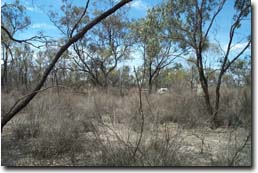Site 36 Second Marsh
Description
This Marsh is one of three in the Avoca River system. It is dominated by Redgum on the floor of the Marsh and is surrounded by Black Box and Eumong on higher ground. This area has been dry for a number of years and provides a habitat for a large number of birds, especially when water is present. Surrounding land uses include grazing and cropping.
Vegetation Description and Composition This site is Woodland dominated by Eucalyptus camaldulensis (Red Gum). On the higher areas the site is dominated by Eucalyptus largiflorens (Black Box) and Acacia stenophylla (Eumong). The understorey is predominantly Muehlenbeckiaflorulenta (Tangled Lignum). Most of the introduced weed species of the Asteraceae family were not present - due likely to the drier seasonal seasons that have changed the ratio of weeds to native plants. The salt indicator species have increased from one to two species in 1998, to three in 1999, and five species in 2002 – declining to three species in 2002/2003. There has also been an increase in area of bare ground, likely due to the recent drier seasonal conditions and extensive grazing by rabbits. Tree health has continued to decline and is most likely due to continued insect attack reducing crown density. Overall there appears to have been minimal change in the vegetation survey results when seasonal conditions are considered, as compared with previous vegetation data. |  Second Marsh |
Water Quality
The Marshes are generally fresh but do become slightly saline (rising to above 6 000 EC) when drying.
Groundwater and Salinity
The groundwater level is currently 5-7 metres below the surface, due mainly to the current dry seasonal conditions. Groundwater salinity is on average about 50 000 EC.
Threats to the site continue to be:
- weed invasion, mainly from the Asteraceae family.
- possible inappropriate water regime.
- regeneration can be severely grazed by kangaroos and rabbits.
Monitoring Survey Dates
December 1997, December 1998, December 1999, December 2000, November 2001, December 2002.


